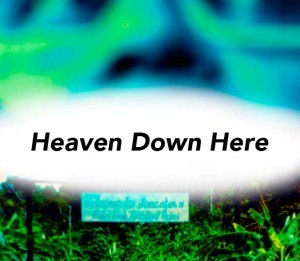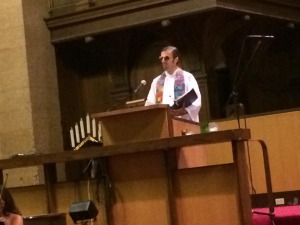“There’s no Heaven up there. We’ll have to make Heaven down here!”
Jim Jones in a 1973 Los Angeles sermon, Q 1057 (Part 2)
I was born nine years after the massacre, and my first encounter with Peoples Temple came from Wikipedia articles. Nothing captured my imagination the way Peoples Temple has. To me, it needed an opera. I found inspiration in the prospect of highlighting a truth that is too often pushed aside. John Eaton wrote a partially-performed opera, and there are small-scale works dealing with Jonestown events, but there have been no large-scale works fully performed. It was time for me to create one.
 Heaven Down Here is a 90 minute chamber opera: a staged presentation of an imaginary last day at Peoples Temple for twenty-five singers, instrumentalists and dancers. It combines sounds of Pentecostal worship, gospel music, operatic oratorio and recitative singing, and experimental improvisation into a three-act musical patchwork narrative in my unique musical language of avant-gospel. It represents years of composing, arranging, re-arranging, experimenting, visioning, researching, discussing with experts, supporters and collaborators, planning, changing plans, rehearsing, choreographing, fundraising, and struggling with difficult and complex ideas and emotions. The work finally had its first two performances on June 25th and 28th. I was simultaneously inspired, thrilled and terrified to see it come to life, and I cannot express enough gratitude to the long list of friends, supporters and collaborators who helped make this dream a reality.
Heaven Down Here is a 90 minute chamber opera: a staged presentation of an imaginary last day at Peoples Temple for twenty-five singers, instrumentalists and dancers. It combines sounds of Pentecostal worship, gospel music, operatic oratorio and recitative singing, and experimental improvisation into a three-act musical patchwork narrative in my unique musical language of avant-gospel. It represents years of composing, arranging, re-arranging, experimenting, visioning, researching, discussing with experts, supporters and collaborators, planning, changing plans, rehearsing, choreographing, fundraising, and struggling with difficult and complex ideas and emotions. The work finally had its first two performances on June 25th and 28th. I was simultaneously inspired, thrilled and terrified to see it come to life, and I cannot express enough gratitude to the long list of friends, supporters and collaborators who helped make this dream a reality.
My vision
I see myself in Peoples Temple. Both Jim Jones and I had roles in majority-black faith communities. My experience as a music director for African-American congregations brought me unexpected power and privilege fueled by racial injustice, a position all too familiar to Jim Jones. The black Pentecostal-inspired worship of Peoples Temple would have been familiar and comforting to me, as I share their demonstrated commitment to Christian-inspired progressive politics and anti-racist socialist message.
I identify with Jones’ and Peoples Temple’s disregard for convention and defiance of outside authority. Jones seemed energized by opposition, and used attacks to portray the Temple and himself as victims, and thereby strengthen his own power. His sharp words against a system embedded with social inequality and racism express a bold disregard for prevailing authority. As I see it, the Temple achieved near total unaccountability, which ultimately permitted the unthinkable.
I am an experimental musician. I challenge established musical conventions. I often reject them with the bold disregard of Peoples Temple. In Heaven Down Here, I use abrasive chords and jagged timbres. I ask singers and instrumentalists to generate discord by improvising variations, or even instruct them to “play anything” for all-out cacophony. When traditional songs appear in the work, they are juxtaposed with contrasting material for a composite sound that is anything but traditional. My commitment to defy convention never waivers, and I take great pride in the original expression it offers.
Nevertheless, through Heaven Down Here, I call on experimentalists in art, spirituality, activism, ideas or ways of living, to examine how easily this independence covers extreme abuse and destruction. I also call on skeptics of experimentation to experience the genuine hope and inspiration it can bring. It is fascinating and disturbing for me to find myself unable to tell where hope and inspiration end, and where abuse and destruction begin in my own work.
Creating an opera
My research began after a day of internet browsing followed by a class on the black church and social change at Northwestern University that spent weeks on Peoples Temple. Fully drawn in, I watched documentaries, and I read books. I talked to experts and people with personal ties to Peoples Temple. I visited sites of old buildings and memorials around Northern California.
When I discovered the FBI tapes transcribed by the Jonestown Institute, I found ample material for an opera libretto. I sifted through sermons and publications and wove lines into a narrative. I incorporated the words and melody to songs on FBI tapes, the 1974 He’s Able album by the Peoples Temple Choir, and others associated with their worship tradition.
 My narrative begins outside a San Francisco worship service. Act I opens as Anne, a fictional Temple member, joins the community and celebrates a faked healing. When she sees Jones throw a Bible, she attempts to leave, only to renew her commitment during Act II. Also in Act II, the Temple’s planning commission convenes to discuss threats, especially former members who expose abuses. During the meeting, Jones realizes he cannot stop the groundbreaking 1977 New West article from publication and leaves for Jonestown. Another worship service convenes to open Act III. Jones now appears only on a television screen, telling congregants to join him in Guyana. Performers begin to exit, departing for Guyana, which suggests both their tragic end and their bold attempt to “make Heaven down here.” The opera ends with an empty stage when the last performer has left.
My narrative begins outside a San Francisco worship service. Act I opens as Anne, a fictional Temple member, joins the community and celebrates a faked healing. When she sees Jones throw a Bible, she attempts to leave, only to renew her commitment during Act II. Also in Act II, the Temple’s planning commission convenes to discuss threats, especially former members who expose abuses. During the meeting, Jones realizes he cannot stop the groundbreaking 1977 New West article from publication and leaves for Jonestown. Another worship service convenes to open Act III. Jones now appears only on a television screen, telling congregants to join him in Guyana. Performers begin to exit, departing for Guyana, which suggests both their tragic end and their bold attempt to “make Heaven down here.” The opera ends with an empty stage when the last performer has left.
With this outline, I composed scenes, and recruited singers and instrumentalists for informal workshops that introduced the music to an audience and to new collaborators. After a fundraising campaign through Indiegogo and Fractured Atlas, I planned two full performances at First Congregational Church of Oakland, California.
Alexis Segel came on board after the first workshop, working behind the scenes (even literally) as an advisor and stage manager for the project. He challenged me to deep research and effective stage presentation. I began working with conductor Katie Harrell a few months later, who helped to coordinate my large ensemble to bring details of the work alive, and also some outstanding singers, including David Peterson who brought a power to the role of Jim Jones that I could not have imagined. A year ago, I also began working with singer, dancer and choreographer Megan Meyer. She added an ensemble of two dancers and achieved a provocative staging for the entire ensemble including the instrumentalists. She also created a video to represent Jones’ propaganda from Jonestown that captured both an apparent tropical paradise and Jones’ own psychological deterioration.
I assembled an ensemble of winds strings, jazz rhythm section, and seven singers and two dancers. I felt that singers who portray Temple members could come from any background and need not represent any particular race or character. People of all backgrounds can experience some kind of oppression and fight against injustice. My cast turned out to be mostly white, with all but one singer being female, but does not represent only the white or female members.
I cannot name everything this experience offered me. The logistical, practical and musical difficulties that arose challenged me to respond in new and creative ways. After fundraising, advertising and outreach, I developed ways of talking about my work and Peoples Temple, and found depth and clarity in discussing surrounding issues.
June performance and beyond
At the June 2014 premiere, the musical language captured an atmosphere that listeners found simultaneously enticing and unsettling. No one sat comfortably for all 90 minutes of music, nor would I want them to. It started conversations, and captured listeners’ imaginations in ways I had not anticipated. It drew an audience that integrated fans of Bay Area experimental arts with members of local communities of faith. Some with personal connections to the Jonestown tragedy told me afterwards they were moved by our handling of the story.
The CD recording from the June 28th performance is available for sale here. I posted samples of the work here, and the entire work is available on Youtube.
(Andrew Jamieson’s latest work is In The Water. He may be reached at AndrewBarnesJam@gmail.com.)